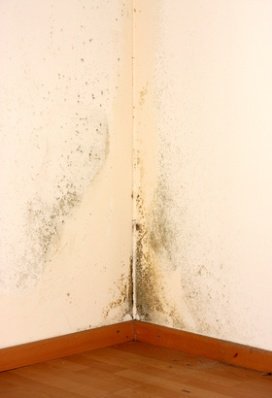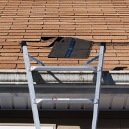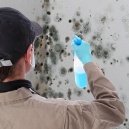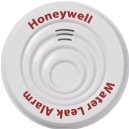Find a pre-screened local mold removal specialist Free Estimate
Find a Mold Specialist Now
Click or Call, Toll-Free 24/7
Chaetomium in The Home
Chaetomium is reported as being one of the most common types of mold found in water-damaged or damp homes. Chaetomium is also sometimes referred to as the “other black mold,” and confused with Stachybotrys chartarum by the average concerned homeowner. This mold can be found on many different types of materials, including wallpaper, drywall, door and window trim, paper, baseboards, carpets, cardboard, and furniture containing cotton. Because Chaetomium loves damp paper so much, it is a constant concern in libraries and book and paper archives.
Chaetomium mold produces an enzyme called cellulase, which breaks down the cellulose in materials, literally destroying them. Sometimes it is also found on food, especially whole foods that contain significant sources of fiber; foods such as whole-grain breads and pastas, quinoa, and brown rice.
This type of mold is also sometimes found growing outdoors on decaying plant matter, in soil, or on animal dung. It is much more commonly found indoors than outdoors, usually resulting from a water damage problem.
What Does It Mean if You Have Chaetomium in Your Home?
When you find mold in your home you probably will not be able to identify it by just looking at it. At least most people can’t. Some homeowners choose to have the mold in their homes tested to see what kind of mold it is, although the U.S. Centers for Disease Control and Prevention (CDC) says that in most cases, that’s not necessary. All kinds of mold are potentially hazardous to your health and need to be removed from indoor environments. Some homeowners do choose to test their homes for mold in order to ascertain health risks. Sometimes they want to find out if mold is present, or maybe they’ve had mold removed by a professional and want to make certain that has been successfully remediated. There are a number of reasons a homeowners will test their homes for mold. Here is some additional information about testing for mold, and when the testing may be recommended.
If mold tests reveal you have Chaetomium mold growing in your home, it means you may have a potentially dangerous mold problem. Chaetomium spores are larger and heavier than the spores of many other types of mold. The concentration level of them in an air sample will usually be fairly low, even when there is a large amount of the mold present in the home. You may find more of the spores in a sample of household dust than you will in a random air sampling.
If you have this kind of mold in your home, it suggests you have, or have had, a chronic moisture problem. This type of mold is usually found in homes with leaky waterlines, a leaky roof, a constantly damp basement, or a home that has suffered a major water loss of some type. If you want to remove the mold and make your home safe again, you’ll need to determine the source of the excessive moisture and remedy it before remediating the mold. Otherwise, you’ll just end up with the mold redeveloping again.
Health Risks From Exposure To Chaetomium Mold
The longer mold remains in your home, the more likely you or members of your family may begin experiencing mold-related health problems. In some cases, being exposed to mold for extended periods of time can cause very serious, and even life-threatening, health complications.
Chaetomium mold produces high quantities of mycotoxins. A mold’s mycotoxins are the cause of many mold-related health symptoms. They can enter your body by breathing them in, by absorption through contact with your skin, or by eating foods with mycotoxins in them (cooking does not always have an effect on mycotoxins; most mycotoxins can survive in temperatures up to 500 degrees Fahrenheit).
This type of mold can cause skin and nail infections, cerebral infections, allergic reactions, and asthma. Autoimmune diseases such as lupus and multiple sclerosis have been linked to Chaetomium mold exposure. Other symptoms could include coughing, memory loss, nose bleeds, seizures, dermatitis, fever, and internal lesions.
Removing Chaetomium from Your Home
Any mold, no matter what species of mold it is, needs to be removed from your home as soon as possible. This is especially true of Chaetomium. The longer mold is allowed to remain in your home, the more likely it is to cause health issues for residents and to spread to other areas of the home, making the cleanup work much more extensive and much more expensive.
Mold often grows in hard-to-detect places such as under carpet, in wall cavities, and inside heating, ventilation and air conditioning (HVAC) units and their ductwork. In order to make sure all areas of mold are located and removed from your home, we suggest scheduling a free home inspection and consultation with a mold remediation professional. An experienced professional will visit your home, assist you in locating all areas affected by the mold, and advise you about the work that needs to be done. You’ll get answers to all your questions along with a written estimate for the costs involved with remediating any existing mold problem. There is no cost for the consultation and no obligation on your part, so you have nothing to lose. You can find qualified mold remediation professionals offering free inspections and consultations in your area by following the link.
Remember that in addition to removing the mold from your home, you’ll need to find the cause of the excessive moisture in your home and correct the problem. A mold remediation professional can help you determine that as well. Likely sources of excess moisture include leaky pipes (check under sinks, behind toilets, and under and around appliances that use water, like hot water heaters, dishwashers and washing machines), leaky roofs, and damp or overly humid basements and crawl spaces. While mold remediation professionals generally don’t repair leaks of any kind, they can help you determine the root cause of your mold problem. You can do the work yourself, but professional advice should always be welcomed, especially when dealing with mold.
Free Home Inspection By A Mold Removal Specialist
Search This Website
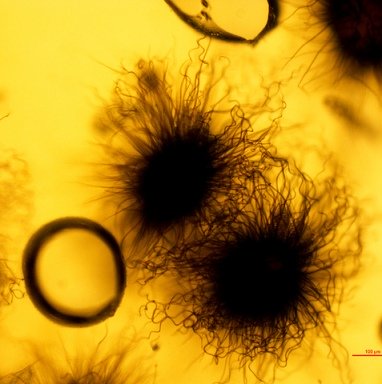 Chaetomium
ChaetomiumRecent Articles
-
See Our 5 Recommended Mold Removal Companies in Aberdeen, SD
Oct 08, 21 04:05 PM
-
Public Housing Tenant Sick from Mold
Apr 24, 20 01:40 PM
-
Mold Types Found In Homes .......Identification, Finding Mold, Testing
Jan 27, 20 02:32 PM
